No plant embodies the tropics better than the palm tree. While the majority of these palms are for gardeners in the subtropics (USDA zones 9 to 11), I've also included some choices for those of you who get freezes every now and then.
You'll learn about palms that tolerate freezes, salt spray, flooding and drought, as well as palms for small spaces, hedges and large areas. For those of you who can't grow palms outdoors through winter, I've even included a list of some of the best palms to grow as houseplants.
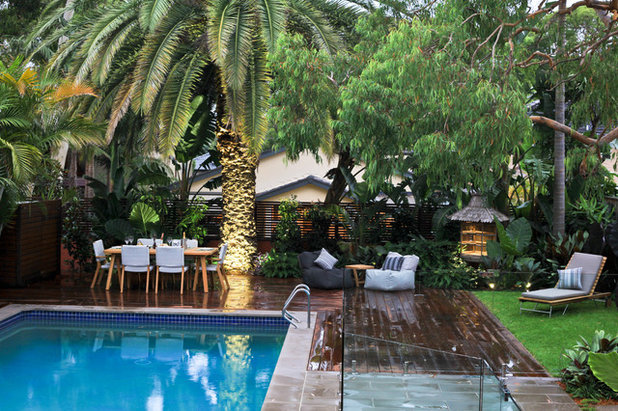
Impressions Landscape - Design
Freeze-Tolerant PalmsFor those of you who get freezes in winter, there are still several palms that will tolerate even hard freezes.
Mediterranean fan palm (
Chamaerops humilis, zones 8 to 11) is a clumping type that tolerates drought and is well suited to courtyards, foundation plantings and other small areas.
Windmill palm is another favorite for temperate climates because of its versatility and resilience.
Gardeners in zones 8b to 9 have even more palm choices forn their palette, since the freezes there aren't quite as harsh.
Radicalis palm (
Chamaedorea radicalis, zones 8b to 11) and
bamboo palm (
Chamaedorea microspadix, zones 8b to 11) are perfect for tight and shady spots, while
pindo palm (
Butia capitata),
mule palm (
Butiagrus, zones 8b to 11) and
Canary Island date palm (
Phoenix canariensis, zones 9 to 11) are suited to open, sunny areas.
Shown: Canary Island date palm
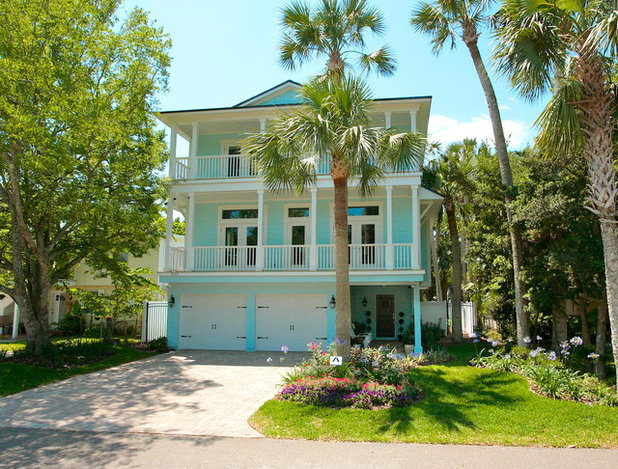
Lendry Homes
Palms for the BeachPalm trees and beaches would seem to go hand in hand, but not all palms can handle the salty and sometimes severely strong winds of the coast.
Coconut palms are the obvious choice, since their floating coconuts sprout up on beaches all over the tropics. The aptly named
seashore palm (
Allagoptera arenaria, zones 9 to 11) is another great one, and it works well as a large shrub since the trunks never leave the ground. For a spreading palm, choose the
palmetto (
Serenoa repens, zones 7b to 11) in either its green or blue form. It's very tolerant of salt, wind and cold, and it even stabilizes the dunes.
Shown: Sabal palm (
Sabal palmetto, zones 8 to 11)
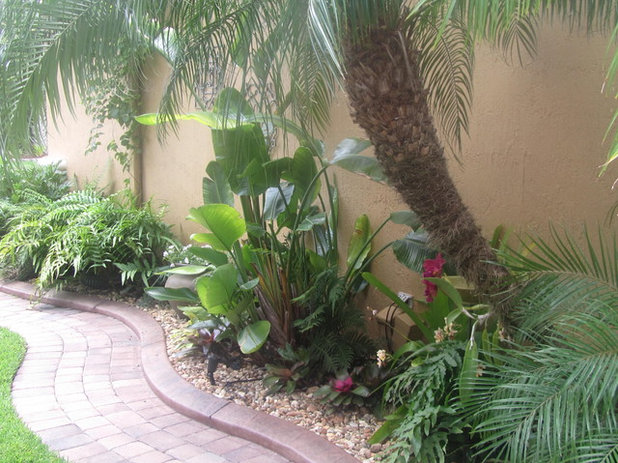 Palms for Small Spaces
Palms for Small Spaces It's a common mistake to plant palm trees in small areas only to find that they're way too big for their new home. There are lots of palms that will fit right in, though, and their smaller fronds stay in scale with their surroundings nicely.
Choose
lady palm (
Rhapis excelsa, zones 8b to 11) for its clustering stems with glossy leaves from head to toe, or look for clumping
bamboo palms (
Chamaedorea spp) for a delicate and lacy look. These palms will handle direct sun but look best with some afternoon shade, so plant them under eaves or taller trees.
Sun-tolerant palms for small areas include
pygmy date palm (
Phoenix roebelinii, zones 9 to 11),
Licuala palms (
Licuala spp, zones 9b to 11), or
Mediterranean fan palm (
Chamaerops humilis, zones 8 to 11) for cooler areas.
One of the perks of using palms in outdoor living areas is that they require much less maintenance and cleanup than other plants.
Shown: Pygmy date palm
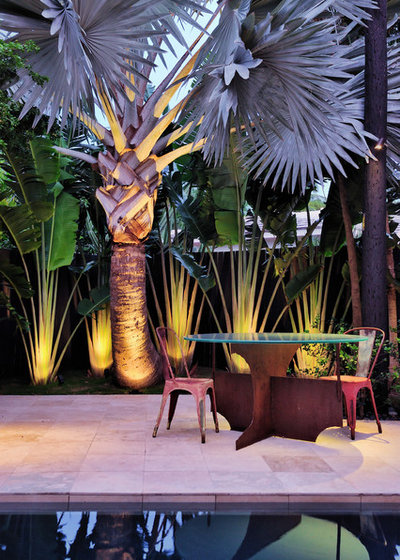 Large Palms for Impact
Large Palms for ImpactIf you have the space and need a bold and architectural palm to serve as a focal point, make room for these massively majestic palm trees.
Bismarck palms (
Bismarckia nobilis, zones 9b to 11) stand out not only for their size, but for their nearly white blue-gray fronds.
Royal palms (
Roystonia regia, zones 9b to 11) and
bailey palms (
Copernica baileyana, zones 10 to 11) are both notable for their huge gray, concrete-like trunks; they're quite popular for lining avenues in affluent areas.
Cohune palm (
Attalea cohune, zones 10 to 11) is magnificently regal even before it forms a trunk, shooting up into the sky with fronds reaching 30 feet long. The finely cut fronds of the giant
fishtail palm (
Caryota gigas, zones 9b to 11) have the delicate appearance of fern fronds, except that they're 20 feet long on a trunk that reaches 60 feet tall.
When planting large palms, make sure that they have not only room to grow, but open space around them so that they can be appreciated from a distance.
Shown: Bismarck palm
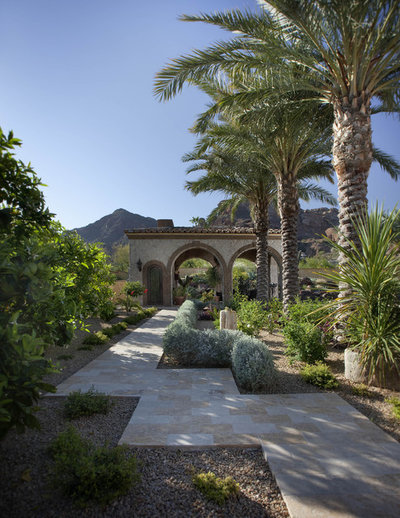
Exteriors By Chad Robert
Drought-Tolerant PalmsThere are many drought-tolerant palms to use in your garden, and some will even tolerate being grown in the desert and do poorly in the humid climates typical of Florida and Hawaii. Just about anyone in a warm climate can grow drought-tolerant palms like
Mediterranean fan palm (
Chamaerops humilis, zones 8 to 11),
Mexican fan palm (
Washingtonia filifera, zones 9 to 11) and
palmetto (
Serenoa repens, zones 7b to 11), and they can be planted in nonirrigated areas without any trouble.
For those of you in Arizona or California, try planting
hesper palms (
Brahea spp, zones 8 to 11) or
mountain coconut palm (
Parajubea cocoides, zones 9 to 11).
If you live in Florida, try planting the native
buccaneer palm (
Pseudophoenix sargentii, zones 9b to 11) to get the look of a royal palm on a smaller scale, not to mention less water.
Shown: Date palm (
Phoenix dactylifera, zones 8 to 11)
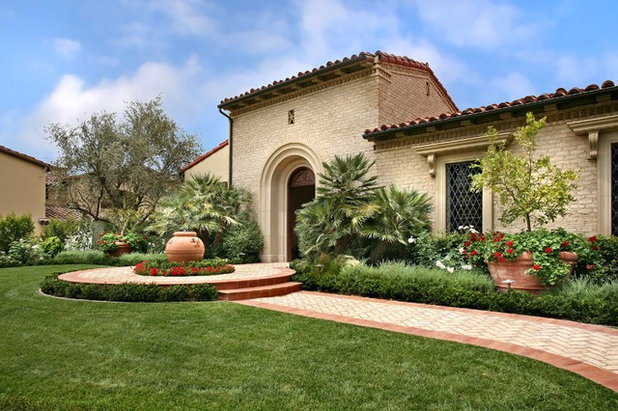
AMS Landscape Design Studios, Inc.
Palms for HedgesFor a different approach to hedges and shrubs, use palms. You might be surprised to learn that some palm trees actually make excellent privacy screens.
Golden cane palm (
Dypsis lutescens, zones 9b to 11) is a popular one, and it takes on golden hues when grown in the sun
. Lady palm (
Rhapis excelsazones, zones 8b to 11) makes a dense and leafy shrub for small spaces, as its small, fanned-out fronds take up very little space.
Dwarf sugar palm (
Arenga engleri, zones 9 to 11) and
fishtail palm (
Caryota mitis, zones 9b to 11) are especially noted for their wavy, fringed leaflets and ruffled texture.
Palms don't need to be trimmed as most hedges do, but you will need to remove creeping stems that get too close to pathways or structures by cutting through them with a sharp knife.
Shown: Mediterranean fan palm (
Chamaerops humilis, zones 8 to 11)
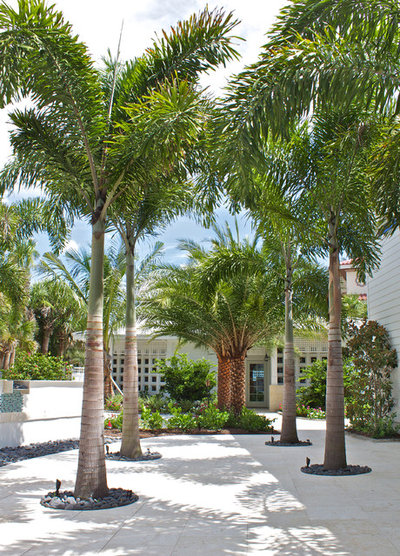
ArtisTree Landscape Maintenance & Design
Palms for Wet AreasIf your garden has a soggy spot, there's a palm for that. Most palms are exceptionally drought tolerant, but some are at their best in constantly moist soil. Florida natives like
everglades palm (
Acoelorraphe wrightii, zones 9 to 11) and
Sabal palm (
Sabal palmetto, zones 8 to 11) tolerate both drought and floods in their habitat and in the garden. Other palms that like to soak their feet once in a while include
pygmy date palm (
Phoenix roebelinii, zones 9 to 11) and
lipstick palm (
Cyrtostachys renda, zone 11). The lipstick palm actually requires practically soggy soil or standing water, so use it in a water feature where you can enjoy the bright, coral-red crownshafts on its trunks.
Shown: Royal palm tree (
Roystonia regia, zones 10 to 11)
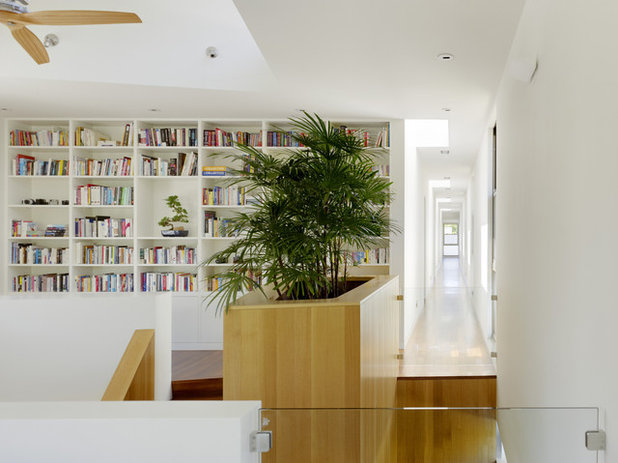 Palms for Indoors
Palms for Indoors Palm trees are pretty common as houseplants, but not all of them really thrive indoors. Avoid palms labeled 'cat palm,' 'areca palm' or 'majesty palm.' One option is
lady palm (
Rhapis excelsa); it usually comes with a higher price tag, but its glossy, tropical-looking leaves and resilient nature make it well worth the investment.
Kentia palm and
sentry palm (
Howea spp) are two other pricy palms, but they're unparalleled for their large crowns of gracefully arching fronds. As far as houseplants go, these are as close to coconut palms as it gets.
The most affordable palm, and the easiest to find, is the dainty
parlor palm (
Chamaedorea elegans). Shown: Parlor palm





